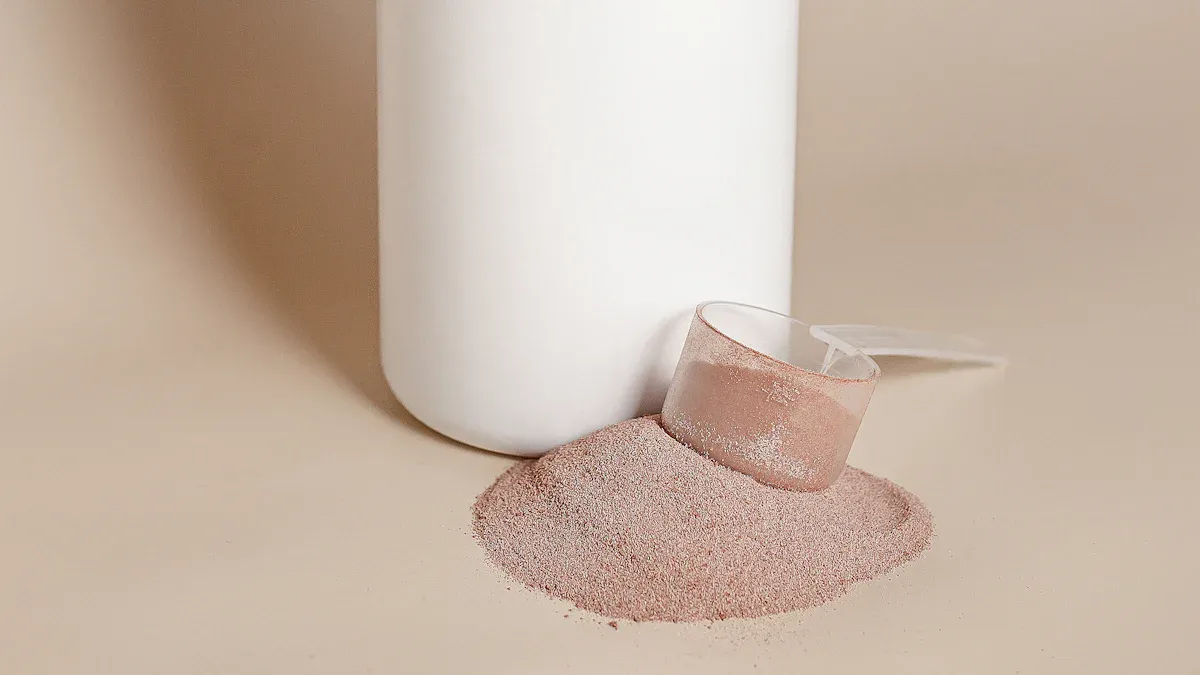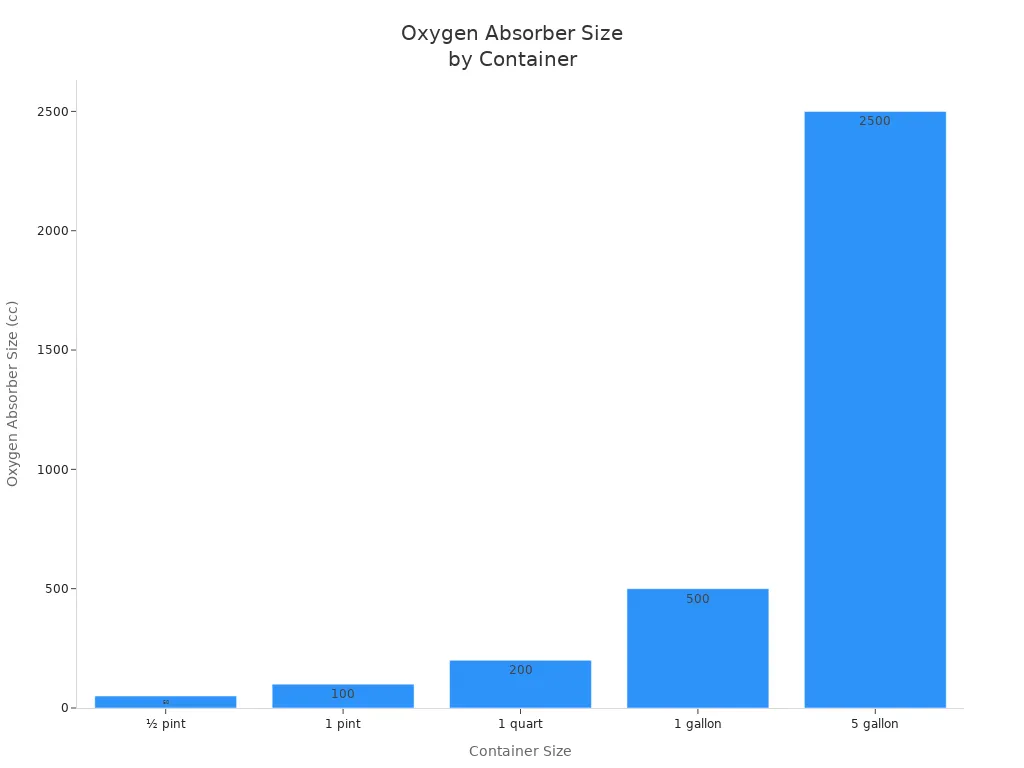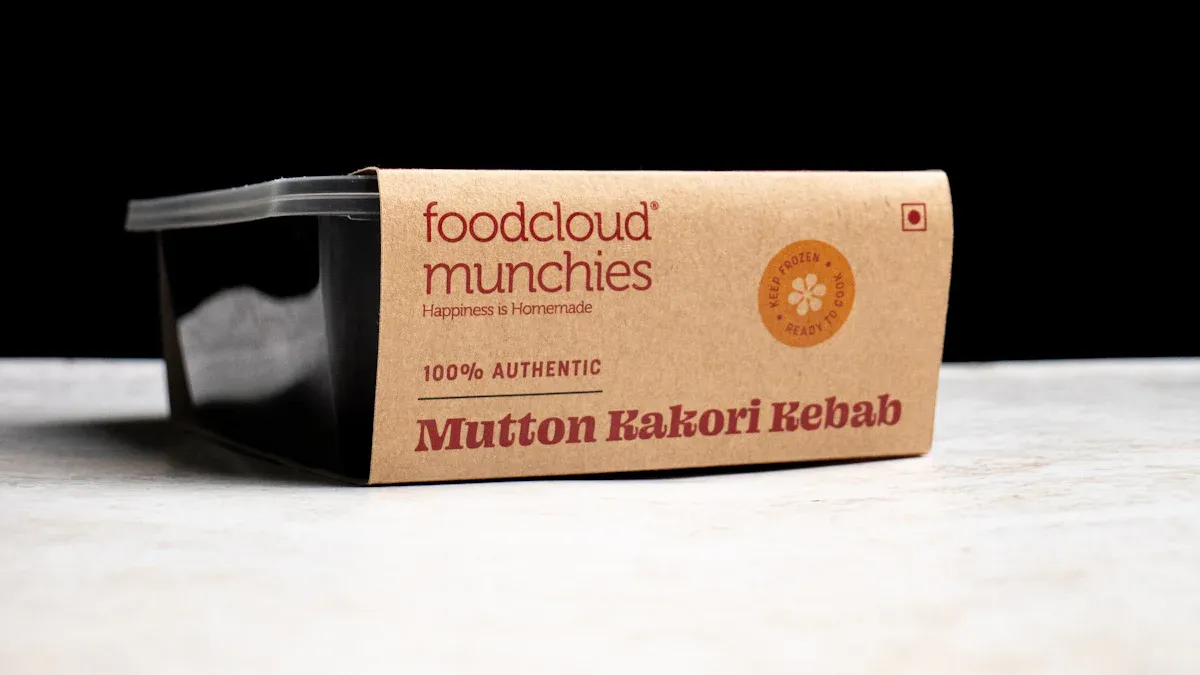
You can pick the right food storage desiccant by using a simple rule. Use about 1.2 units for each cubic foot of space. Bigger containers have more air and can hold more moisture. So, you will need more desiccant for them. The kind of food and Desiccant Type are important too. Look at a sizing chart before you pack. Always choose food grade desiccant to stay safe.
Key Takeaways
Use 1.2 units of desiccant for each cubic foot. This helps keep your food dry.
Look at a gram-size chart to pick the right pack. Make sure it fits your container size.
Match the desiccant type to the food you store. Dry foods need less desiccant. Moist foods need more.
Always pick food-grade desiccants for safety. This helps you avoid contamination.
Measure your container’s volume carefully. This helps you know how much desiccant you need.
Keep desiccant packets in a cool, dry place. Do not open them until you use them.
Check desiccant packets often for moisture. Replace them if they look wet or full.
Avoid mistakes by using the right desiccant size. Watch your storage conditions closely.
Food storage desiccant sizing

Quick sizing rules
1.2 units per cubic foot
You can use a simple rule to figure out how much food storage desiccant you need. For every cubic foot of space in your container, use at least 1.2 units of desiccant. This rule helps you keep food dry and safe. If you have a rigid container, you can multiply the volume in cubic feet by 1.2 to get the right amount. This method works well for most dry goods and grains.
Tip: Always measure your container before you buy desiccant packs for food storage. This helps you avoid using too little or too much.
Gram-size chart for containers
You can also use a gram-size chart to pick the right desiccant pack. The chart below shows the recommended sizes for common containers. These numbers help you keep food fresh during long-term food storage.
Container Size | Recommended Desiccant Size |
|---|---|
Half-pint | 2g desiccant pack |
1 pint | 3g desiccant pack |
1 quart | 5g desiccant pack |
1 gallon | 10g desiccant pack |
5 gallon | 50g desiccant pack |
5-6 gallon pail | 50g desiccant pack |
You can use this chart when you buy desiccant packs for food storage. It makes the process easy and quick.
Sizing for common containers
Jars and buckets
Jars and buckets come in many sizes. You need to match the desiccant pack to the container size. For a 1-gallon jar, use a 10g desiccant pack. For a 5-gallon bucket, use a 50g pack or several smaller packs. This keeps moisture away from your food.
If you use a half-pint jar, a 2g pack works well. For a quart jar, pick a 5g pack. Always seal your jars and buckets tightly after adding the food storage desiccant.
Mylar bags and vacuum sealers
Mylar bags and vacuum sealers help you store food for a long time. Mylar bags often use oxygen absorbers to remove air. This creates a safe space for your food. Vacuum sealers pull out air and seal the bag tightly. This lowers the risk of spoilage.
You should still buy desiccant packs for food storage when using Mylar bags, especially for dry foods. Use the same gram-size chart to pick the right pack. For example, a 1-gallon Mylar bag needs a 10g desiccant pack. A 5-gallon bag needs a 50g pack.

Note: Mylar bags and vacuum sealers work best when you use both oxygen absorbers and food storage desiccant. This keeps your food dry and safe for months or years.
How to choose the right size desiccant pack
Picking the right desiccant pack is important for food storage. You want your food to stay dry and safe. Follow these steps to use the right amount.
Measure container volume
First, measure your container. Find out how much space your food will fill. Here are the steps:
Measure the length, width, and height in inches or centimeters.
Multiply these numbers to get the total volume.
If you use inches, divide by 1,728 for cubic feet. If you use centimeters, divide by 1,000 for liters.
Use the rule: For each cubic foot, use about 1.2 units of desiccant.
If your container has a strange shape, measure the surface area. Multiply the surface area by the desiccant conversion factor to get what you need.
Tip: Always round up your measurements. It is safer to use a little extra desiccant.
Match desiccant to food type
Different foods need different amounts of desiccant. Think about what you are storing.
Dry goods vs. moist foods
Dry goods like beans, rice, and pasta need less desiccant. These foods do not have much moisture.
Moist foods, such as fruits and baked goods, need stronger desiccants. Moisture can cause mold and spoilage.
Freeze-dried foods need desiccants to keep them crisp. Desiccants stop moisture from getting in when you open the container.
Dehydrated vegetables need desiccants to soak up leftover moisture and stop mildew.
Powdered foods
Powdered foods, like spices and protein powders, need more desiccant. This stops clumping and keeps the powder dry.
Use small packets for tight spaces and big packets for large containers.
Always check your food’s moisture before packing.
Adjust for storage conditions
Storage conditions change how much desiccant you need. Think about humidity, temperature, and packaging.
You should know how your desiccant works in different conditions. Molecular sieve keeps lower humidity than silica gel. This helps protect sensitive foods.
Decide what humidity level you want inside your container.
Check if your food has leftover moisture.
Look at your packaging. Some bags let in more water vapor.
Add more desiccant if you expect high humidity or long storage.
Include the headspace and any gaps in your calculations.
Follow these steps:
Find the starting humidity inside your container.
Choose the humidity level you want for your food.
Use a stronger desiccant if you store food in a humid place.
Example calculations for common containers
Here is a table to help you pick the right desiccant for popular container sizes:
Container Size | Units of Desiccant Required | Typical Gram Size |
|---|---|---|
1-gallon | 1/6 unit | 10g |
5-gallon | 1 unit | 50g |
1-gallon Mylar bag | 1/6 unit | 10g |
5-gallon Mylar bag | 1 unit | 50g |
If you use a 1-gallon jar, pick a 10g pack. For a 5-gallon bucket, use a 50g pack. Mylar bags use the same rule. Always check the chart before you buy your food storage desiccant.
Remember, learning how to pick the right size desiccant pack helps you keep your food fresh and safe for a long time.
Using desiccant packets for food storage

Placement in containers
You want your desiccant packets to work as well as possible. Start by choosing the right type for your food. Silica gel works well for packaged foods in places with moderate humidity. Place the packets in the corners of your container. Moisture often collects there, so this helps the packets absorb water evenly. Make sure you seal your container tightly. If air gets in, moisture can build up and spoil your food. Dry the inside of your container before you add food and packets. This step helps the packets last longer, especially if you store food in hot or humid weather. Watch for temperature changes. If the temperature goes up and down, moisture can sneak in. You may need to add more packets if you notice this happening.
Tip: Always check that your container is dry and clean before you add food and desiccant packets.
Number of packets to use
You need to know how many packets to use for your container. The number depends on the size and type of your container. Use the formulas below to help you decide:
Container Type | Formula for Desiccant Calculation |
|---|---|
Flexible | units of desiccant required = 1.6 x A (in sq. ft.) or 0.011 x A (in sq. in.) |
Rigid | units of desiccant required = K x V, where K = 0.161 (in gal.) or 0.0007 (in Cu. in.) or 1.2 (in Cu. ft.) and V = volume (in gal., Cu. in. or cu. ft.) |
For flexible containers, measure the surface area. Multiply by 1.6 if you use square feet. For rigid containers, measure the volume. Multiply by 1.2 if you use cubic feet. Round up if you are unsure. It is better to use a little extra than not enough. Always check the food type. Powders and dried foods may need more packets than beans or rice.
Note: If you use large containers, spread the packets out. This helps them absorb moisture from every part of the container.
When to replace or recharge
Desiccant packets do not last forever. You need to replace or recharge them to keep your food safe. Silica gel packets change color when they get wet. You can dry them in an oven at 250°F (120°C) for a few hours. They will turn back to their original color and work again. Clay desiccants also need to dry out. Put them in the sun or use a low-temperature oven. Check your packets every few months. If you see moisture or mold in your container, replace the packets right away.
Alert: Never use damaged or dirty packets. Always recharge or replace them before you store new food.
Desiccant packets for food storage help you keep your food fresh and dry. If you follow these steps, you will protect your food from moisture and spoilage.
Storage and handling tips
You want your desiccant packets to stay effective and safe. Good storage and careful handling help you get the most out of each packet. Follow these tips to keep your food fresh and your desiccant working well.
How to store desiccant packets:
Keep packets in a sealed container until you use them. Airtight jars or zip-top bags work well.
Store packets in a cool, dry place. Heat and humidity can make them lose strength.
Use a label to mark the date you opened the packet. This helps you track freshness.
Avoid direct sunlight. Sunlight can damage some types of desiccant.
Handling tips for best results:
Wash your hands before you touch desiccant packets. Clean hands stop dirt and oils from getting on the packets.
Use clean tweezers or gloves if you handle many packets at once.
Place packets in the container quickly. The longer they stay out, the more moisture they absorb from the air.
Never cut or open a packet. The contents can spill and cause problems.
Tip: If you drop a packet or it gets wet, replace it right away. Wet packets cannot protect your food.
Organizing your desiccant supply:
Tip | Why It Helps |
|---|---|
Use a storage box | Keeps packets together |
Separate new and used | Stops mix-ups |
Write sizes on packets | Makes picking easier |
Keep a checklist | Tracks when to recharge |
You can use a simple checklist to stay organized:
Check packet color or freshness every month.
Mark packets that need recharging.
Replace old packets before packing new food.
Safety reminders:
Keep desiccant packets away from children and pets. Some packets look like candy.
Read the label before you use a packet. Only use food grade desiccant for food storage.
Do not reuse packets from non-food items. These may contain unsafe chemicals.
Alert: Always seal your storage containers after you add desiccant packets. This step keeps moisture out and protects your food.
You can keep your food safe and dry by following these storage and handling tips. Careful handling helps you avoid mistakes and keeps your desiccant packets working for a long time.
Food grade silica gel desiccant safety
What makes desiccant food grade
You want your food to stay safe while it is stored. Food grade silica gel desiccant follows strict safety rules. Companies must obey rules from groups like the FDA or EFSA. These rules make sure the desiccant will not hurt you or your food. Factories use clean tools and keep the area controlled. The packaging also keeps the desiccant clean and safe. You can look at the table below to see what makes a desiccant food grade.
Aspect | Details |
|---|---|
Safety Standards | Must comply with FDA or EFSA approvals for non-toxicity and food safety |
Production Requirements | Must meet hygiene standards and use controlled manufacturing processes |
Packaging Standards | Must use packaging that meets food-contact safety standards |
Tip: Always check for food grade labels on desiccant packs before using them with food.
Types safe for food storage
You have a few choices for food-safe desiccants. Silica gel is the most popular kind. The FDA says silica gel is safe to touch food. Bentonite clay is another good choice. The FDA calls bentonite clay GRAS, which means it is safe. Montmorillonite clay is also GRAS. You can use these types with dry foods, grains, or powders.
Silica Gel: FDA says it is safe for food contact
Bentonite Clay: Non-toxic, acid-free, and GRAS by the FDA
Montmorillonite Clay: GRAS by the FDA
The table below shows which type works best for different foods.
Desiccant Type | FDA Status | Best Fit |
|---|---|---|
Silica Gel | FDA approved for direct contact | Everyday dry goods needing moisture control |
Montmorillonite Clay | Generally Recognized As Safe (GRAS) | Products stored in climate-controlled areas |
Note: Always pick food grade silica gel desiccant or other food-safe types for storing food.
Avoiding contamination
You want to keep your food safe from contamination. Food-grade desiccants are safe and not toxic. Regular desiccants might have bad chemicals. Some can be dangerous if you eat them. If water gets in, microbes can grow. Humidity can move smells and tastes between foods. Sticky spots can spread allergens. Non-food grade desiccants do not follow strict safety rules. For example, calcium chloride can make you sick if you eat it.
Food-grade desiccants: Safe, non-toxic, FDA recognized for direct contact
Regular desiccants: Might be unsafe, corrosive, or harmful if swallowed
Microbial transfer: Water helps microbes grow on food or packaging
Chemical and sensory transfer: Humidity can move bad smells and flavors
Allergen cross-contact: Wet spots can spread allergens
Alert: Only use desiccants made for food storage. Never use packets from shoes, electronics, or other things not meant for food.
You keep your food and health safe when you pick the right desiccant. Always use only food-safe desiccants in every container.
Troubleshooting desiccant use
Too little or too much desiccant
You need the right amount of desiccant to keep food fresh. If you use too little, moisture can spoil your food. If you use too much, your food might get too dry. This can change how your food tastes and feels. Some foods need a little moisture to stay good. Using extra desiccant costs more money for no reason.
Here are some things that can happen:
Too much desiccant dries out food and changes taste.
Using extra desiccant costs more but does not help.
Not enough desiccant lets moisture ruin your food.
Tip: Always check the recommended size for your container and food type. This helps you control humidity and avoid problems.
Signs of moisture problems
Watch for signs that moisture is getting into your food. If you see these signs, your desiccant may not be working well. You might need to add more.
Stale food, clumps, or mold mean too much moisture.
Mold and bacteria grow if humidity gets too high.
Bad smells or mold show moisture problems.
Extra packaging like plastic wrap can trap moisture.
If you notice any of these problems, check your desiccant packs. Replace them if needed. Good moisture control keeps your food safe and fresh.
Alert: If you smell something strange or see mold, do not eat the food. Fix the moisture problem before storing more.
Common mistakes
People sometimes make mistakes when using desiccant for food storage. You can avoid these problems by following simple steps. The table below shows common mistakes, what happens, and how you can fix them.
Mistake | Description | Fix |
|---|---|---|
Guessing Desiccant Size | Picking packet sizes by habit, not by calculation. | Calculate water load and use humidity logging. |
Using the Wrong Desiccant Chemistry | Choosing the wrong type for your food or environment. | Match chemistry to product and environment. |
Dropping Packets Where They Get Crushed | Packets get damaged during sealing. | Drop packets just before sealing and keep them clear. |
Ignoring Film Changes | Not adjusting for new packaging materials. | Recalculate packet size with any film changes. |
Sealing Product While it is Still Warm | Warm food vents moisture and saturates desiccant. | Let food cool before sealing. |
Letting Desiccants Pre-Saturate | Storing packets in humid places reduces effectiveness. | Store packets in sealed bins with low humidity. |
Skipping In-Pack Monitoring | Not checking humidity inside containers. | Use miniature RH loggers to monitor conditions. |
Never Revisiting Legacy Specs | Using outdated packet sizes or specs. | Re-audit specs regularly. |
Forgetting Arrival Checks | Not checking packets after delivery. | Use an inbound checklist for quality. |
Treating Moisture Control in Isolation | Ignoring other factors like temperature. | Consider all factors in your moisture control plan. |
Note: You can avoid most mistakes by planning ahead and checking your storage often. Always use the right desiccant for your food and container.
You can keep food safe by matching the right food storage desiccant to your container and food type. Use the chart to pick the right size. Always choose food-grade packets to avoid contamination. Here is a quick checklist:
Measure your container.
Pick the right food storage desiccant size.
Use only food-grade packets.
Replace damaged or wet packets.
Tip | Why It Matters |
|---|---|
Store extras airtight | Stops moisture from ruining them |
Watch for color changes | Shows when to recharge or replace |
Keep your food fresh by checking packets often and storing them in a cool, dry place.
